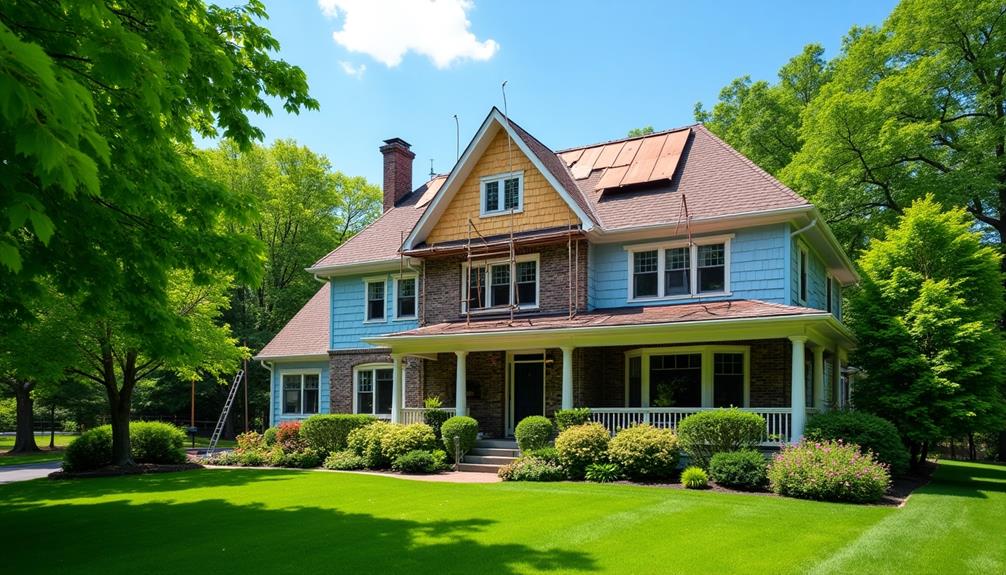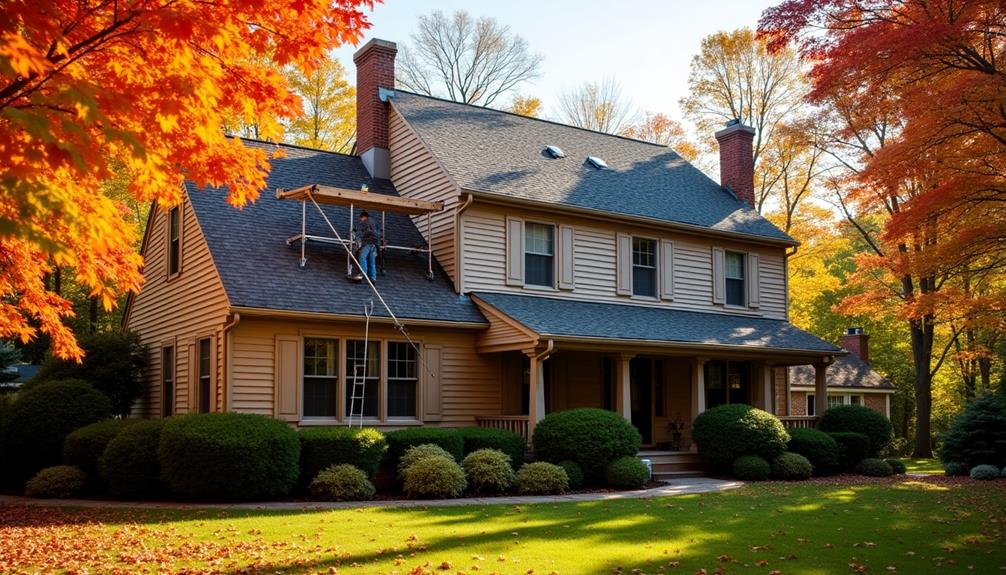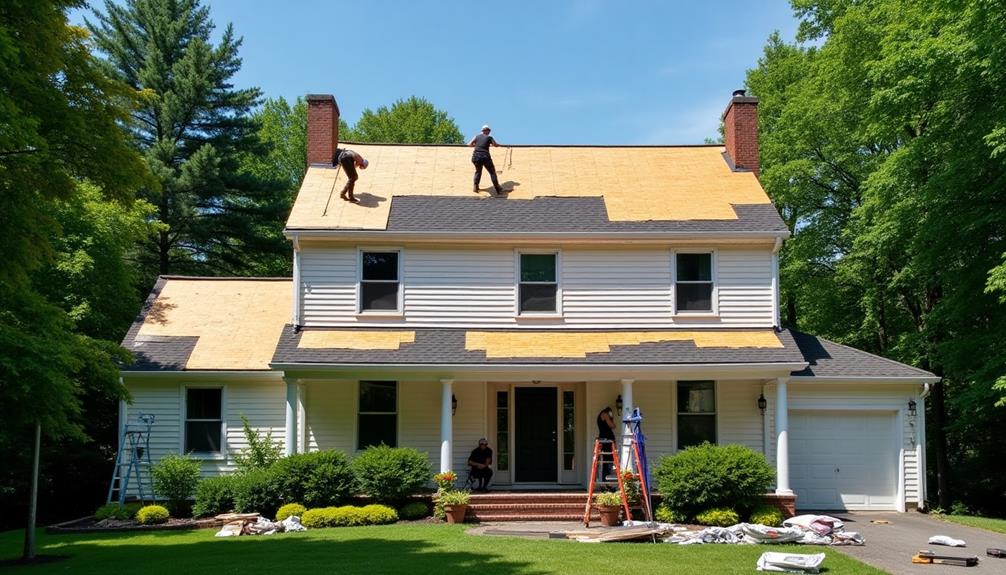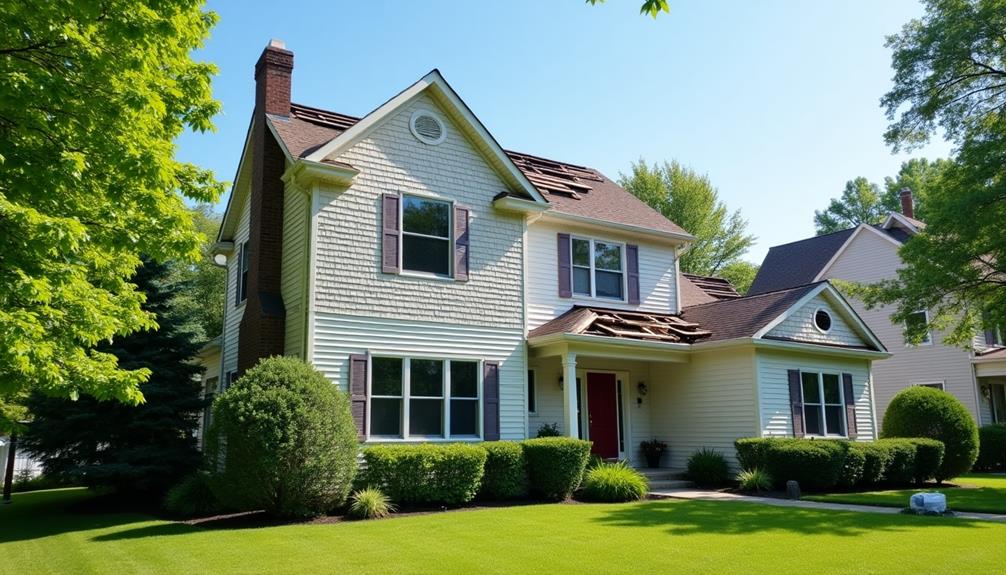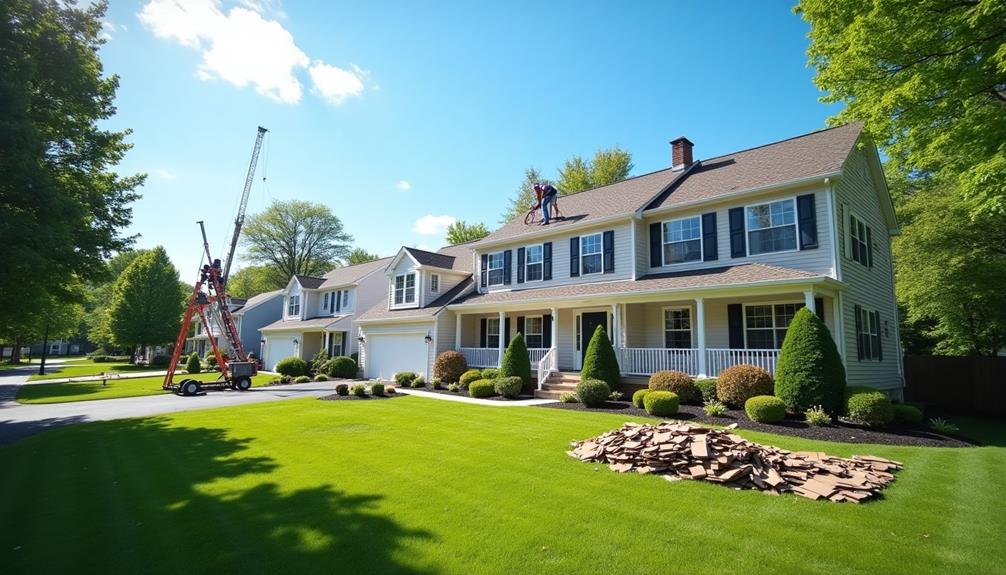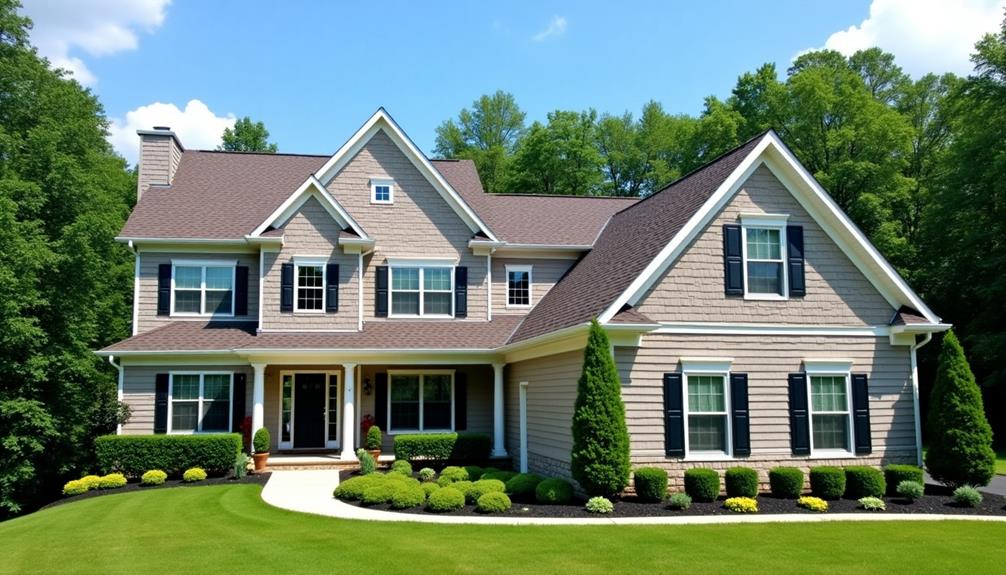If you're considering roof replacement in Princeton, NJ, look for signs like cracked shingles, water leaks, or moisture in your attic. Roofs over 20 years old often need replacement due to material fatigue. Choosing quality materials can save you money in the long run, as options like metal and slate offer better durability. Costs depend on factors like roof size and material choice, so it's wise to compare estimates from local contractors who are licensed and insured. Understanding maintenance tips post-replacement helps extend your roof's lifespan. Explore further to uncover essential details that can help you make informed decisions.
Signs You Need a Replacement
When it comes to your roof, knowing the signs that you need a replacement can save you from costly repairs down the line. One of the most obvious indicators is shingle deterioration. If you notice cracked, curled, or missing shingles, it's time to take action. These issues compromise your roof's ability to protect your home against the elements.
Another critical sign is the presence of water leaks. If you find water stains on your ceilings or walls, it could indicate that your roof isn't functioning properly. Ignoring these leaks can lead to mold growth, structural damage, and even health risks for your family.
Additionally, check your attic for signs of moisture or daylight peeking through; these are strong indicators that your roof needs urgent attention.
Lastly, if your roof is over 20 years old, it's wise to consider a replacement, even if it appears to be in decent condition. Age alone can lead to material fatigue, making your roof more susceptible to damage.
Staying proactive about these signs ensures that you maintain the integrity of your home and avoid more significant, costly repairs in the future.
Choosing the Right Materials
When choosing materials for your roof replacement, it's crucial to consider both durability and cost-effectiveness.
Higher-quality materials may have a higher upfront cost but can save you money in the long run through reduced maintenance and replacement needs.
Material Durability Considerations
Choosing the right materials for your roof isn't just about aesthetics; it's crucial for ensuring long-lasting durability. You'll want to focus on options that provide excellent weather resistance and an extended material lifespan. This way, you can avoid frequent repairs and replacements, which can be costly and inconvenient.
Here's a quick comparison of common roofing materials based on durability:
| Material | Weather Resistance | Material Lifespan |
|---|---|---|
| Asphalt Shingles | Moderate | 15-30 years |
| Metal Roofing | High | 40-70 years |
| Slate | Very High | 75+ years |
| Wood Shingles | Low to Moderate | 20-30 years |
| Composite Shingles | Moderate to High | 30-50 years |
Cost vs. Longevity Analysis
Balancing cost and longevity is essential for any roofing project, as it directly impacts your investment over time. When choosing materials, you'll want to weigh upfront costs against potential long-term savings. Cheaper materials might seem appealing initially, but they often require more frequent replacements and repairs, ultimately increasing your overall expenses.
Consider investment factors like durability, maintenance, and energy efficiency. For instance, asphalt shingles are less expensive but typically last only 15-30 years. In contrast, metal roofing may have a higher initial cost, yet it can last 50 years or more with minimal maintenance, providing significant savings over its lifespan.
Additionally, energy-efficient materials can reduce your heating and cooling costs, enhancing your long-term savings. By investing in high-quality roofing materials now, you're likely to minimize future expenditures and maximize your return on investment.
Ultimately, the right roofing material choice hinges on balancing your budget with your long-term goals. Make an informed decision based on your specific needs and priorities, ensuring that your roof serves you well for many years to come.
Cost of Roof Replacement
Understanding the cost of roof replacement is crucial for homeowners in Princeton, NJ, as it can significantly impact your budget and long-term plans. The overall cost varies based on factors like roof size, material choice, and complexity of the installation.
Asphalt shingles are typically the most affordable option, while metal and slate roofs might demand a higher investment.
When assessing your budget, consider financing options available to you. Some roofing companies offer flexible payment plans, making it easier to manage the expense over time.
Additionally, if your roof has sustained damage due to a storm or other covered events, you might be eligible for insurance claims. This can alleviate some financial burdens, but it's essential to understand your policy details and the claims process to maximize your benefits.
Hiring a Local Contractor
When hiring a local contractor for your roof replacement, it's crucial to verify their credentials and insurance to ensure you're working with a qualified professional.
Assessing the quality of their previous work can provide insights into their reliability and craftsmanship.
Don't forget to compare multiple estimates to find the best value for your investment.
Verify Credentials and Insurance
Choosing the right contractor for your roof replacement project in Princeton, NJ, hinges on verifying their credentials and insurance.
Start by checking the licensing requirements in your state. A reputable contractor should hold a valid license, which demonstrates their adherence to local building codes and regulations. This ensures they've the necessary training and qualifications to handle your project safely and effectively.
Next, don't overlook the importance of insurance coverage. A reliable contractor should carry both liability insurance and workers' compensation.
Liability insurance protects you from financial responsibility if any damage occurs during the project, while workers' compensation ensures that any injuries sustained on the job won't fall on you.
Request copies of these insurance documents to confirm their validity.
Assess Previous Work Quality
Evaluating a contractor's previous work quality is crucial for ensuring a successful roof replacement in Princeton, NJ.
You'll want to focus on specific roof inspection techniques that highlight the contractor's capabilities and attention to detail. Begin by asking for examples of their past projects, particularly those similar in scope and complexity to yours.
Next, apply quality assessment criteria such as durability, aesthetics, and adherence to local building codes. Look for evidence of proper materials used and craftsmanship that withstands time and weather conditions.
Request references from previous clients and don't hesitate to follow up. Their feedback can provide invaluable insights into the contractor's reliability and work ethic.
Don't forget to check for any documented complaints with local consumer protection agencies. A contractor's reputation can tell you a lot about their work quality.
Finally, be sure to review any warranties or guarantees offered. A quality-focused contractor should stand behind their work, demonstrating confidence in the results you can expect.
Compare Multiple Estimates
Gathering multiple estimates for your roof replacement project in Princeton, NJ, can significantly impact your decision-making process. By comparing different proposals, you can better understand the market rates and services available. When you receive estimates, make sure to assess them based on specific comparison criteria, such as materials used, labor costs, and warranty options.
Here's a breakdown of what to look for in each estimate:
| Contractor Name | Estimate Breakdown | Warranty Options |
|---|---|---|
| Contractor A | $8,000 – Asphalt Shingles | 10 years, limited |
| Contractor B | $9,500 – Metal Roofing | 20 years, transferable |
| Contractor C | $7,500 – Architectural Shingles | 15 years, limited |
Reviewing the estimate breakdown helps you identify the best value for your investment. Don't just look at the bottom line; consider the quality of materials and the experience of the contractor. It's crucial to ensure you're not sacrificing quality for a lower price. Taking the time to compare these estimates will empower you to make an informed choice that meets your roofing needs.
Preparing for the Replacement
Before you dive into the roof replacement process, it's crucial to prepare adequately to ensure a smooth experience.
Start by assessing your home's design considerations. Think about the architectural style, as some materials may complement your home better than others. Additionally, consider factors like color and texture to enhance curb appeal.
Next, pay attention to seasonal timing. Replacing your roof during moderate weather conditions is ideal; avoiding extreme heat or cold can prevent complications with installation.
Spring and early fall are typically the best seasons for roofing projects, as they offer a balance of favorable temperatures and dry conditions.
Don't forget to check local regulations and permits required for your roof replacement. This can save you time and hassle later on.
Maintenance After Replacement
Once your new roof is installed, maintaining it properly is key to ensuring its longevity and performance. One of the first steps you should take is scheduling post replacement inspections.
These inspections allow you to identify any potential issues early on, ensuring that your roof remains in top condition. Make it a habit to inspect your roof at least twice a year, ideally during spring and fall.
Seasonal maintenance is essential. In the spring, clear any debris like leaves and branches that can trap moisture and lead to mold growth.
Check gutters for blockages; they should be free-flowing to prevent water damage. In the fall, inspect for loose or damaged shingles and address any issues immediately.
Don't forget about the attic—it's crucial to ensure proper ventilation and insulation. This prevents heat buildup and reduces the risk of ice dams in winter.

